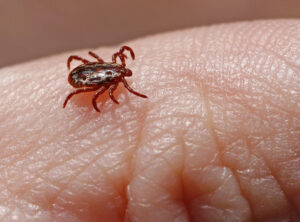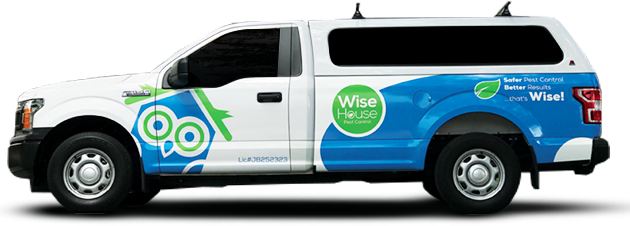In South Florida, American dog ticks pose a significant risk to both pets and humans. These ticks are particularly concerning because both adults and nymphs can transmit serious diseases, including Tularemia and Rocky Mountain Spotted Fever (RMSF). RMSF is a potentially life-threatening condition that can cause severe symptoms such as respiratory issues, vomiting, rash, fever, and abdominal pain.
Given these risks, it’s important for South Florida residents to be aware of the dangers posed by American dog ticks. In this post, we cover the risks associated with American dog ticks and provide practical tips on how to safeguard your pets and family from their potential threats.

The American dog tick (Dermacentor variabilis) is a common tick species found throughout the United States, including South Florida. Known for being a prime carrier of various diseases, this tick primarily infests dogs but can also affect other mammals, including humans.
Size: American dog ticks are medium to large compared to other tick species. Adult females can reach up to 1/2 inch (13 mm) in length when fully engorged with blood. Males are slightly smaller but can still be quite noticeable.
Color: These ticks are typically reddish-brown with a distinctive white or grayish pattern on their back. This coloration helps in identifying them, especially when they are not yet engorged.
Shape: The American dog tick has a flat, oval-shaped body that becomes more rounded and engorged after feeding. It has eight legs and a noticeable head (capitulum) that can be seen protruding from the body.
Mobility: American dog ticks are adept at climbing onto hosts but are not strong fliers. They use a behavior known as “questing,” where they climb onto vegetation and wait with extended legs to grasp onto a passing host.
Active Hours: These ticks are most active during the warmer months, from early spring to late summer, though they can be present year-round in some areas. They are particularly active during periods of high humidity and warmth. American dog ticks are often found in grassy and brushy areas, as well as in areas with tall vegetation. They are commonly encountered in outdoor environments but can also be found in indoor spaces if brought in by pets.
Life Cycle
Behavior
Feeding Habits—American dog ticks attach to a host and feed on blood for several hours to a couple of days. During feeding, they inject saliva containing anticoagulants to facilitate blood flow, which can also transmit pathogens.
Infestation Patterns—These ticks are commonly found in grassy and brushy areas. They are less likely to infest indoor environments compared to some other tick species but can be brought indoors on pets.
Disease Transmission
American dog ticks are known for carrying several diseases, including Rocky Mountain Spotted Fever (RMSF) and Tularemia. RMSF can cause severe health issues such as fever, rash, and abdominal pain. While these diseases are more common in certain regions, it is important to be aware of the risks in your area.
American Dog Tick Habitat
American dog ticks prefer outdoor environments with tall grass and brush where they can easily find hosts. They are particularly common in rural and suburban areas but can also be encountered in urban parks and green spaces.
Understanding the characteristics and behavior of American dog ticks is essential for effective prevention and control. By recognizing their distinctive features and knowing their preferred habitats, you can take proactive measures to protect your pets and family from tick-borne diseases.
Physical Characteristics
Signs of Infestation
Protect Your Pets
Maintain Your Home
Outdoor Precautions
The American Dog Tick can pose a significant threat to both pets and homeowners in South Florida. By staying informed about tick identification, understanding the associated risks, and implementing effective prevention and control measures, you can protect your home and family from these pests. Regular maintenance and vigilance are key to ensuring a tick-free environment and maintaining your family’s health and well-being.
Yes, dog ticks are present in Florida, including the American dog tick and the brown dog tick. These ticks are commonly found in wooded and grassy areas and can also thrive inside homes or kennels.
Ticks are indeed a concern in South Florida due to the state’s warm climate, which allows for a nearly year-round active tick season. Preventative measures, such as proper landscape maintenance and using tick repellents, are recommended to manage their population.
The most prevalent tick-borne diseases in Florida include Rocky Mountain spotted fever, ehrlichiosis, and tularemia. These diseases are primarily transmitted by ticks such as the American dog tick and the lone star tick
The American dog tick, scientifically known as Dermacentor variabilis, is known for its presence across the United States, including Florida. This tick is a significant carrier of pathogens like the bacteria causing Rocky Mountain spotted fever.

Ready to send away pests without harming your pets? Getting started with Wise House Environmental Services is as easy as 1-2-3:
With Wise House Environmental Services, you get more than just effective pest control; you get peace of mind, knowing that your home is without pests and safer for your pets.
Our approach to pest control combines science with safety, offering you the kind of targeted, effective solutions that you won’t find with just any other pest control service. Our services have made a world of difference for homeowners, and we can do the same for you. Your pets will thank you for it!
We serve Port St. Lucie,Lake Worth, Boyton Beach, Palm Beachand the Treasure Coast.


© 2023 All Rights Reserved. | Sitemap